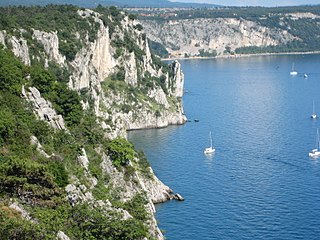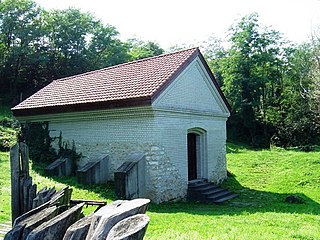
Mithraism, also known as the Mithraic mysteries or the Cult of Mithras, was a Roman mystery religion centered on the god Mithras. Although inspired by Iranian worship of the Zoroastrian divinity (yazata) Mithra, the Roman Mithras is linked to a new and distinctive imagery, with the level of continuity between Persian and Greco-Roman practice debated. The mysteries were popular among the Imperial Roman army from about the 1st to the 4th century CE.

Fontus or Fons was a god of wells and springs in ancient Roman religion. A religious festival called the Fontinalia was held on October 13 in his honor. Throughout the city, fountains and wellheads were adorned with garlands.

The London Mithraeum, also known as the Temple of Mithras, Walbrook, is a Roman Mithraeum that was discovered in Walbrook, a street in the City of London, during a building's construction in 1954. The entire site was relocated to permit continued construction and this temple of the mystery god Mithras became perhaps the most famous 20th-century Roman discovery in London.

A Mithraeum(Latin pl. Mithraea), sometimes spelled Mithreum and Mithraion, is a Mithraic temple, erected in classical antiquity by the worshippers of Mithras. Most Mithraea can be dated between 100 BC and 300 AD, mostly in the Roman Empire.

The Karst Plateau or the Karst region, also locally called Karst, is a karst plateau region extending across the border of southwestern Slovenia and northeastern Italy.

Tauroctony is a modern name given to the central cult reliefs of the Mithraic Mysteries in the Roman Empire. The imagery depicts Mithras killing a bull, hence the name tauroctony after the Greek word tauroktonos. A tauroctony is distinct from the sacrifice of a bull in ancient Rome called a taurobolium; the taurobolium was mainly part of the unrelated cult of Cybele.

Santa Prisca is a titular church of Rome, on the Aventine Hill, for Cardinal-priests. It is recorded as the Titulus Priscae in the acts of the 499 synod.
Arimanius is a name for an obscure deity found in a few Greek literary texts and five Latin inscriptions. It is supposed to be the opponent of Oromazes, the god of light. In classic texts, in the context of Zoroastrianism, Areimanios fairly clearly refers to the Greeks' and Romans' interpretation of the Persian Ahriman. The Latin inscriptions which were found in a Mithraic context suggest a re-defined or different deity with a near-identical name.

Carrawburgh is a settlement in Northumberland. In Roman times, it was the site of a 3+1⁄2-acre (1.5 ha) auxiliary fort on Hadrian's Wall called Brocolitia, Procolita, or Brocolita. This name is probably based on the Celtic name for the place, and one possible translation put forward is 'badger holes'. The fort there was a mile or so west of the Wall's northernmost point at Limestone Corner, and just over a mile west of the nearest milecastle, Milecastle 30. The fort either used the Wall itself as its northern rampart, or was built parallel to it but detached. It certainly postdates both the Wall and the vallum.

The Fertőrákos Mithraeum is a temple to the Roman god Mithras at Fertőrákos in Hungary. The temple, follows a typical plan of a narthex followed by the shrine proper that consists of a sunken central nave with podium benches on either side.
Rudchester Mithraeum is a Roman temple to the Roman god Mithras at Rudchester (Vindobala), an auxiliary fort on Hadrian's Wall, the northern frontier of Roman Britain. The temple was located 137m to the west of the castra. It is not currently visible to visitors to the site.
St. John the Baptist Church is a church in San Giovanni di Duino, a hamlet which forms part of the comune of Duino-Aurisina in the Province of Trieste, north-east Italy. It is located at the resurgence of the Timavo and is notable for the remains of a palaeo-Christian basilica.
The Roman cult of Mithras had connections with other pagan deities, syncretism being a prominent feature of Roman paganism. Almost all Mithraea contain statues dedicated to gods of other cults, and it is common to find inscriptions dedicated to Mithras in other sanctuaries, especially those of Jupiter Dolichenus. Mithraism was not an alternative to other pagan religions, but rather a particular way of practising pagan worship; and many Mithraic initiates can also be found worshipping in the civic religion, and as initiates of other mystery cults.

Zerzevan Castle, also known as Samachi Castle, is a ruined Eastern Roman castle, a former important military base, in Diyarbakır Province, southeastern Turkey. Archaeological excavations at the site revealed the existence of underground structures, among them a temple of Mithraism, a mystery religion. The castle was used as a civilian settlement between the 1890s and the 1960s. The site is partly open to tourism.
The Tienen Mithraeum is a Mithraic temple constructed in the Belgian municipality of Tienen in the third century CE.
On the Cave of the Nymphs in the Odyssey is a treatise by the Neoplatonist philosopher Porphyry. It is an exegesis of a passage from Homer's Odyssey, which Porphyry interprets as an allegory about the cosmos and the soul.

The Mithraeum of Dura Europos was found during excavations in the city in 1934. It is considered to be one of the best-preserved and best-documented cult buildings of Mithraism.

The Mithra Temple of Maragheh, also referred to as the Mithra Temple of Verjuy or simply Mehr Temple is a place of worship of the Aryan (Indo-Iranian) god, Mitra ( ,) a mysterious underground place of prayer in northwestern Iranian city of Maragheh dating back to thousands of years ago, is located in Iran, 6 km southeast of Maraghe city in the village of Varjuvy, in Āzarbāyegān Province and is one of the oldest surviving Mithraic temple in Iran known to date.
c.f. Underland by Robert MacFarlane Pub. Hamish Hamilton 2019.pp 189–193



















